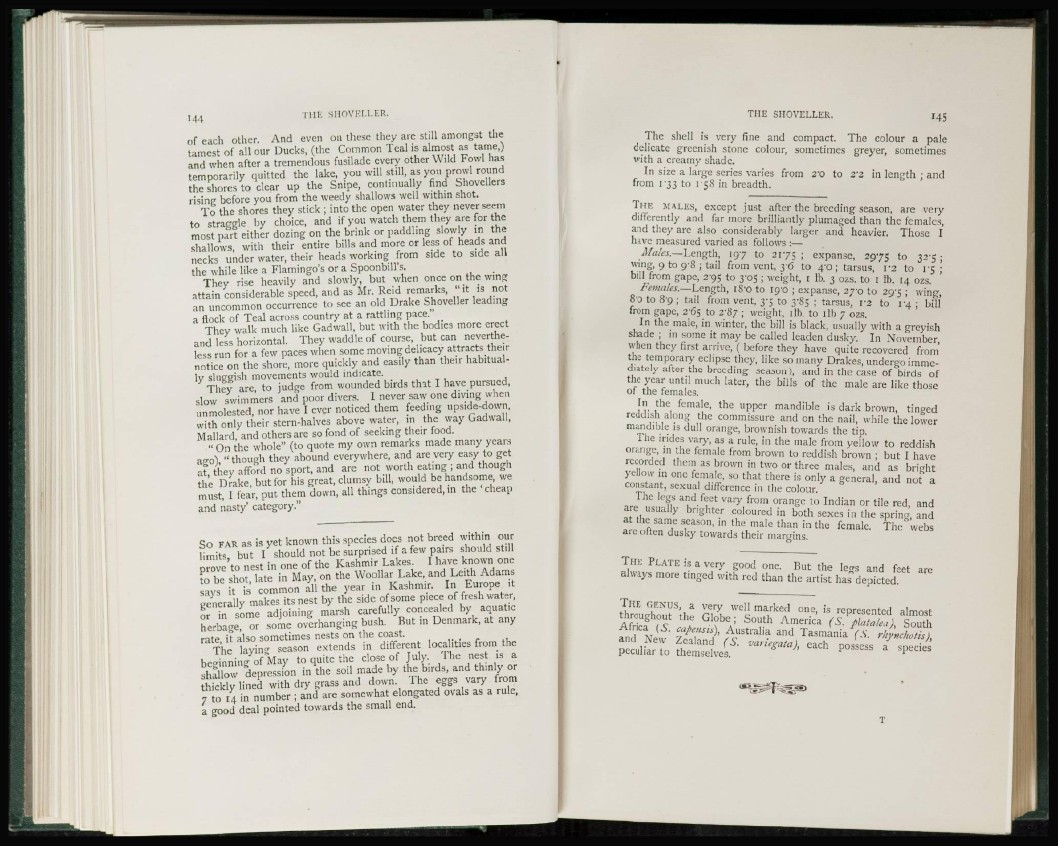
of each other. And even on these they are still amongst the
tamest of all our Ducks, (the Common Teal is almost as tame,)
and when after a tremendous fusilade every other Wild Fowl has
temporarily quitted the lake, you will still, as you prowl round
the shores to clear up the Snipe, continually find Shovellers
rising before you from the weedy shallows well within shot.
To the shores they stick ; into the open water they never seem
to straggle by choice, and if you watch them they are for the
most part either dozing on the brink or paddling slowly in the
shallows, with their entire bills and more or less of heads and
necks under water, their heads working from side to side all
the while like a Flamingo's or a Spoonbill's.
They rise heavily and slowly, but when once on the wing
attain considerable speed, and as Mr. Reid remarks, " it is not
an uncommon occurrence to see an old Drake Shoveller leading
a flock of Teal across country at a rattling pace."
They walk much like Gadwall, but with the bodies more erect
and less horizontal. They waddle of course, but can nevertheless
run for a few paces when some moving delicacy attracts their
notice on the shore, more quickly and easily than their habitually
sluggish movements would indicate.
They are, to judge from wounded birds that I have pursued,
slow swimmers and poor divers. I never saw one diving when
unmolested, nor have I ever noticed them feeding upside-down,
with only their stern-halves above water, in the way Gadwall,
Mallard, and others are so fond of seeking their food.
" On the whole" (to quote my own remarks made many years
ago), " though they abound everywhere, and are very easy to get
at, they afford no sport, and are not worth eating ; and though
the Drake, but for his great, clumsy bill, would be handsome, we
must, I fear, put them down, all things considered,in the 'cheap
and nasty' category."
So FAR as is yet known this species docs not breed within our
limits, but I should not be surprised if a few pairs should still
prove to nest in one of the Kashmir Lakes. I have known one
to be shot, late in May, on the Woollar Lake, and Leith Adams
says it is common all the year in Kashmir. In Europe it
generally makes its nest by the side of some piece of fresh water,
or in some adjoining marsh carefully concealed by aquatic
herbage, or some overhanging bush. Rut in Denmark, at any
rate, it also sometimes nests on the coast.
The laying season extends in different localities from the
beginning of May to quite the close of July. The nest is a
shallow depression in the soil made by the birds, and thinly or
thickly lined with dry grass and down. The eggs vary from
7 to 14 in number ; and are somewhat elongated ovals as a rule,
a good deal pointed towards the small end.
The shell is very fine and compact. The colour a pale
delicate greenish stone colour, sometimes greyer, sometimes
with a creamy shade.
In size a large series varies from 2'0 to 2'2 in length ; and
from 1*33 to 158 in breadth.
THE MALES, except just after the breeding season, are very
differently and far more brilliantly plumaged than the females,
and they are also considerably larger and heavier. Those I
have measured varied as follows :—
Males.—Length, 197 to 2175 ; expanse, 2975 to 32-5 ;
wing, 9 to 9 8 ; tail from vent, 36 to 4#o ; tarsus, 1/2 to 1*5;
bill from gape, 2'95 to 3x35 ; weight, 1 lb. 3 ozs. to 1 lb. 14 ozs.
Females.—Length, iS'o to I9'0 ; expanse, 27^0 to 29-5 ; wing,
80 to 8'9 ; tail from vent, 3'5 to 3'§5 ; tarsus, 12 to I'4 ; bill
from gape, 2'65 to 2'87 ; weight, 1 lb to lib 7 ozs.
In the male, in winter, the bill is black, usually with a greyish
shade ; in some it may be called leaden dusky. In November,
when they first arrive, ( before they have quite recovered from
the temporary eclipse they, like so many Drakes, undergo immediately
after the breeding season), and in the case of birds of
the year until much later, the bills of the male are like those
of the females.
In the female, the upper mandible is dark brown, tinged
reddish along the commissure and on the nail, while the lower
mandible is dull orange, brownish towards the tip.
The irides vary, as a rule, in the male from yellow to reddish
orange, in the female from brown to reddish brown ; but I have
recorded them as brown in two or three males, and as bright
yellow in one female, so that there is only a general, and not a
constant, sexual difference in the colour.
The legs and feet vary from orange to Indian or tile red, and
are usually brighter coloured in both sexes in the spring, and
at the same season, in the male than in the female. The webs
are often dusky towards their margins.
THE PLATE is a very good one. But the Ieo-s and feet are
always more tinged with red than the artist has depicted.
throughout the Al W £ c m a , r k 6 . d ° n e ' i s r e P r e ^ n t c d almost
Africa ?¥ , t ? V S O l , t h A m e r k a <S- P^talea), South
and New" # W A™*'"*? Tasmania (S. rhynehotis),
pecuharTo fhetsdve^' " W < ^ 1 V*
T